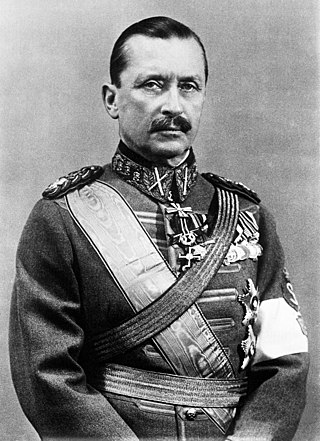
Baron Carl Gustaf Emil Mannerheim was a Finnish military leader and statesman. He served as the military leader of the Whites in the Finnish Civil War (1918), as Regent of Finland (1918–1919), as commander-in-chief of the Finnish Defence Forces during the period of World War II (1939–1945), and as the sixth president of Finland (1944–1946). He became Finland's only field marshal in 1933 and was appointed honorary Marshal of Finland in 1942.

Paavo Juho Talvela was a Finnish general of the infantry, Knight of the Mannerheim Cross and a member of the Jäger movement. He participated in the Eastern Front of World War I, the Finnish Civil War, the Finnish Kinship Wars, the Winter War and the Continuation War.

Ernst Ruben Lagus, better known as Ruben Lagus, was a Finnish major general, a member of the Jäger Movement and the recipient of the first Mannerheim Cross. He participated in the Eastern Front of World War I as a volunteer of the 27th Royal Prussian Jäger Battalion, in the Finnish Civil War as battalion commander and as a supply officer in the Winter War. During the Continuation War, he commanded an armoured brigade, later division, which had a significant role in the influential Battle of Tali-Ihantala.

The Order of the Cross of Liberty is one of three official state orders in Finland, along with the Order of the White Rose of Finland and the Order of the Lion of Finland.

Franz Friedrich Böhme was an Army officer who served in succession with the Austro-Hungarian Army, the Austrian Army and the German Wehrmacht. He rose to the rank of general during World War II, serving as Commander of the XVIII Mountain Corps, Hitler's Plenipotentiary Commanding General in the Balkans, and commander-in-chief in German-occupied Norway during World War II. After the war, Böhme was transferred to U.S. custody as a defendant in the Hostages Trial on charges of having massacred thousands of Serbian civilians. He committed suicide in prison.

Lauri A. Heino was a Finnish soldier, awarded the Mannerheim Cross on 11 November 1943. At the time, he held the rank of sergeant and was serving as a tank driver in the 3rd Company, I Armoured Battalion of the Finnish Armoured Brigade.
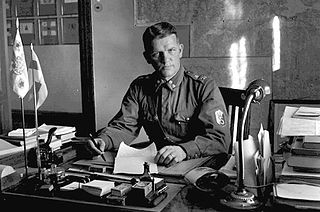
Aaro Olavi Pajari was a Major General in the Finnish Army. During World War II, he became one of the four double recipients of the Mannerheim Cross 2nd Class.
Walter Hartmann was a German general in the Wehrmacht during World War II. He was a recipient of the Knight's Cross of the Iron Cross with Oak Leaves and Swords of Nazi Germany.

Lauri Nissinen was a World War II flying ace in the Finnish Air Force.

Gustaf Erik Magnusson was a Finnish major general and Mannerheim Cross Knight. He was the commander of the No. 24 Squadron and Flying Regiment 3 during World War II. He also flew 158 sorties as a fighter pilot and shot down 5 1/2 enemy aircraft.

Nils Edward Katajainen was a Finnish fighter pilot and a Mannerheim Cross Knight. He held the military rank of sergeant major. He flew 196 sorties and shot down 35 enemy aircraft.

Kaiho Tuomas Albin Gerdt was a Finnish soldier and Knight of the Mannerheim Cross, numbered #95. He was born in Heinävesi. Gerdt, serving as a junior runner officer in the infantry regiment 7, was awarded the Mannerheim Cross on 8 September 1942. At that time he held the rank of a sergeant. After coming home from the war on 13 November 1944, Gerdt worked as a manager in Oy Wilh. Schauman Ab and as an office manager in Oy Kaukas Ab and Kymmene Oy. Gerdt, serving as the chairman of the Mannerheim Cross Knight Foundation, was the last living Knight of the Mannerheim Cross.

Lieutenant General Viking Sebastian Henricsson Tamm was a Swedish Army officer. In addition to the years he served in the Swedish Army, Tamm led a group of Swedish officers who developed the Ethiopian military school's officer training and he was a volunteer in the Winter War in Finland in 1940 commanding the II. Battlegroup of the Swedish Volunteer Corps. Back in Sweden he eventually became Chief of the Army Staff and the General Staff Corps (1948–53) and commander of the I Military District (1953–61) before retiring as a Lieutenant General in 1961.
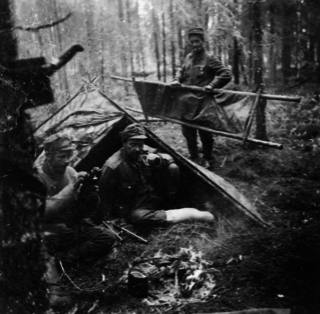
Operation Hokki was a military operation that took place during World War II. The mission's objective was to destroy the railway yards of Petrozavodsk in order to prevent the enemy from supplying its troops in the Battle of Ilomantsi. The mission was conducted by Finland between 31 July 1944 and 31 August 1944 during the Continuation War. Because of the many setbacks that occurred, the objective of the mission was changed and the Finnish troops ended up destroying a large portion of railroad tracks that were being used to supply the Soviet troops in Ilomantsi. Operation Hokki is the only known Finnish airborne operation during World War II and was the largest landing operation in Finnish history.
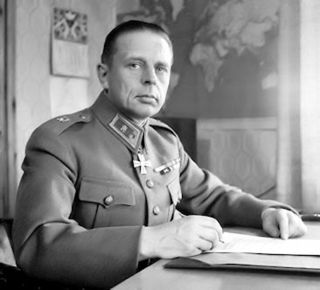
Armas-Eino Martola was a Finnish general of the infantry, a knight of the Mannerheim Cross and a member of the Jäger Movement. He participated in the Eastern Front of World War I, the Finnish Civil War, the Winter War and the Continuation War. In his later years, he acted as the military advisor to the Secretary-General of the United Nations Dag Hammarskjöld and led the United Nations Peacekeeping Force in Cyprus from 1966 to 1969.

Antero Johannes Svensson was a Finnish major general, a member of the Jäger Movement and a recipient of the Mannerheim Cross. He participated in the Eastern Front of World War I as a volunteer of the 27th Royal Prussian Jäger Battalion, in the Finnish Civil War as a platoon and squadron commander, the Winter War as a brigade and division commander, and the Continuation War as a division and corps commander.
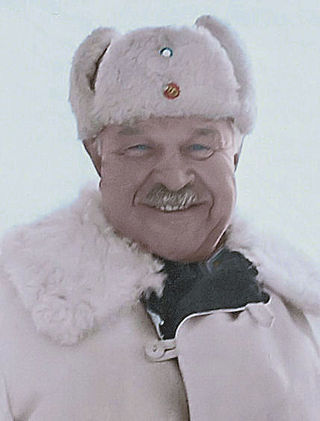
Taavetti Laatikainen was a Finnish General of Infantry and a member of the Jäger movement. He fought in the Eastern Front of World War I, the Finnish Civil War, the Winter War and the Continuation War. During the last of these, he was awarded the Mannerheim Cross of Liberty 2nd Class. Before the Winter War, he commanded both the Reserve Officer School and the Officer Cadet School. He retired in 1948 from the position of Inspector of Infantry.
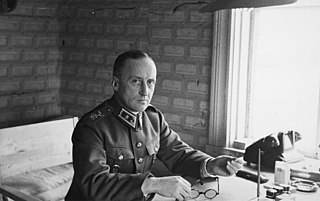
Aarne Leopold Blick was a Finnish lieutenant general, Knight of the Mannerheim Cross and a member of the Jäger movement. He participated in the Eastern Front of World War I, the Finnish Civil War, the Winter War and the Continuation War.


![Knights of the Mannerheim Cross, from left to right: Captain Eero Kivela [fi], Major General Aaro Pajari, Captain Juho Possi [fi], and Corporal Vilho Ratto Marskin ritareita!.jpg](http://upload.wikimedia.org/wikipedia/commons/thumb/d/d4/Marskin_ritareita%21.jpg/250px-Marskin_ritareita%21.jpg)

















